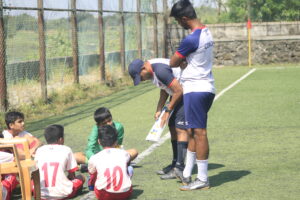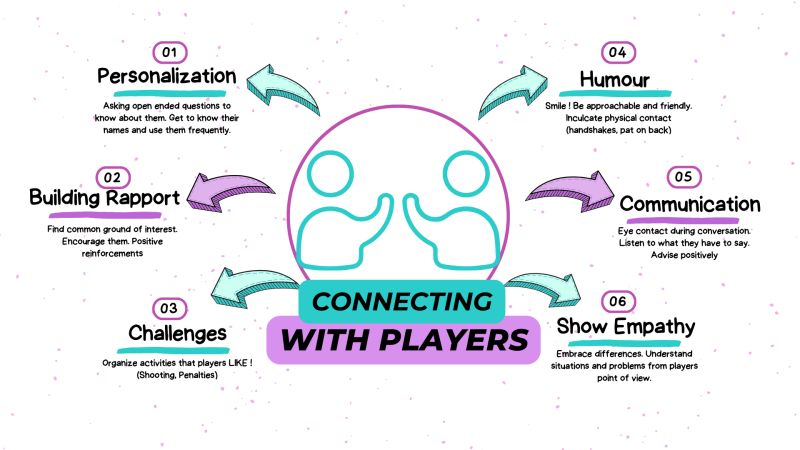
Rita Pierson TEDX podcast on ‘𝐄𝐯𝐞𝐫𝐲 𝐊𝐢𝐝 𝐧𝐞𝐞𝐝𝐬 𝐚 𝐜𝐡𝐚𝐦𝐩𝐢𝐨𝐧‘ emphasized on values and importance of human connection,it is quoted as below.
“𝘒𝘪𝘥𝘴 𝘥𝘰𝘯’𝘵 𝘭𝘦𝘢𝘳𝘯 𝘧𝘳𝘰𝘮 𝘱𝘦𝘰𝘱𝘭𝘦 𝘵𝘩𝘦𝘺 𝘥𝘰𝘯’𝘵 𝘭𝘪𝘬𝘦”
“𝘕𝘰 𝘴𝘪𝘨𝘯𝘪𝘧𝘪𝘤𝘢𝘯𝘵 𝘭𝘦𝘢𝘳𝘯𝘪𝘯𝘨 𝘤𝘢𝘯 𝘰𝘤𝘤𝘶𝘳 𝘸𝘪𝘵𝘩𝘰𝘶𝘵 𝘢 𝘴𝘪𝘨𝘯𝘪𝘧𝘪𝘤𝘢𝘯𝘵 𝘳𝘦𝘭𝘢𝘵𝘪𝘰𝘯𝘴𝘩𝘪𝘱”
In same way teaching and learning FOOTBALL must bring joy to the coach on every level to nurture and build long-lasting relationship
Here are few ideas to 𝘤𝘰𝘯𝘯𝘦𝘤𝘵 𝘸𝘪𝘵𝘩 𝘵𝘩𝘦 𝘱𝘭𝘢𝘺𝘦𝘳𝘴.
1. Personalization

Familiarize with the player
Every player is unique and different in their own way, so it’s vital to understand and connect with them on personal level. By having little to more information about them help us coaches to ask about their well being. Every player likes it when he/she is being called by their name and respected by coaches and teammates.
Being animated
It’s important to consider player’s interest and preferences. Younger children love it when their coach is animated and relates footballing terms in animated way. For example, if children loves cars, coach can design activities that make them visualize their football as car and tells them to use different parts of foot as car gears.
Multisensory approach
Each players learn in their own way. As a coach it’s important to incorporate learning methods such as visual, auditory, read/write, and kinesthetic approach to cater to different individuals within the team.
Provide preferences
To empower the players and make them more invested into footballing activities it’s important to provide preferences, so they can choose what is better for them. It could be making them form team, choosing team formation, giving them leadership opportunities
2. Building Rapport
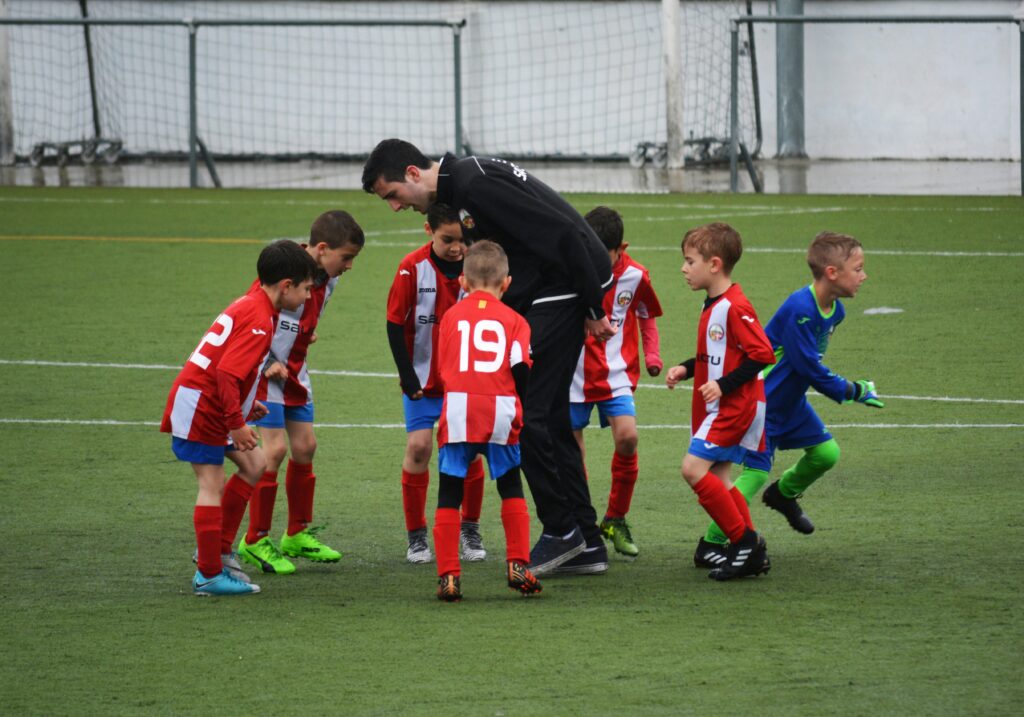
Building coach-player relationship
It is essential to build trust, motivate them and construct positive learning environment, and fostering meaningful relationships.
Being authentic
Coach must show genuine interest. It’s important to be yourself and show your genuine personality. Children imitate behavior of their coach in many ways, so it’s vital to maintain distance and at the same time maintaining rapport with your player.
Praise them for efforts
Praising and using encouraging words for the player in front of the team can bring confidence and self-esteem. Coach must celebrate players achievements, no matter how big or small.
3. Challenges

Daily/Weekly
Every children loves to compete and challenge their peers. Planning soccer training session and adding measurable challenges like juggling skills, first touch, toe taps, ball mastery etc can help them improve their technical skills and become better version of themselves.
During the Game
Matchdays are more encouraging because players love to showcase their skills against the opponent team and try to win for the team. For example, if the coach have worked on defending session recently, challenges such as successful tackles and ball win must be added so the players will be more focused on task than the overall score.
During training session
It is well said that your practice emulates how well your players will perform in the match. Individual player who are excellent with their technical abilities must be challenged so they are not just comfortable doing everyday actions but do something out of the box.
4. Humour
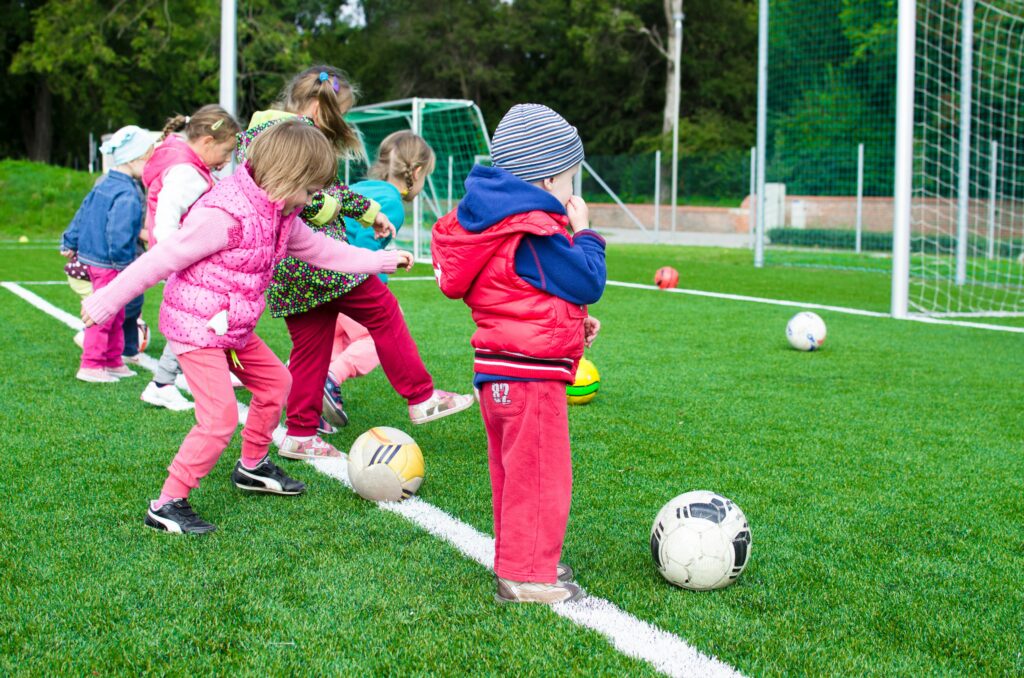
Understand your players
Understand individual personalities and preferences of your players to tailor your humor accordingly. Few players might appreciate sarcasm, while others might prefer easy jokes or witty banter.
Humor as teaching method
Incorporate humor into your coaching sessions and feedback to make it more engaging and memorable. Make use of analogies, funny anecdotes, or playful metaphors to illustrate difficult concepts or techniques.
Share Memories
Creating good memories and laugh together over it can strengthen bonds and create a sense of unity within the team. Encourage players to laugh together and celebrate moments of joy and camaraderie.
5. Communication
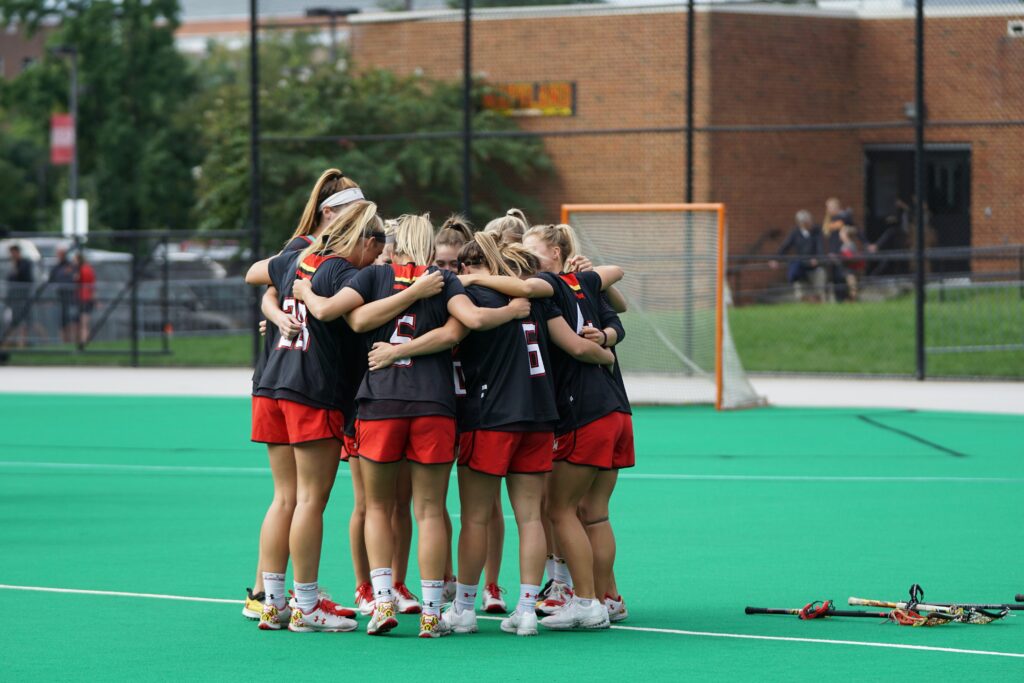
Be active Listener
Coach must have genuine interest in what the child is saying by actively listening without interruption. Incorporating nonverbal cues such as nodding and maintaining eye contact conveys attentiveness.
Clear and Concise message
By delivering messages in a clear and concise manner, helps avoid miscommunication, one must avoid using difficult jargons, instead use simple sentences and relatable words to provide specific instructions to ensure understanding.
Communication Style
Coach must consider that players have different communication preferences and adapt to your approach accordingly. Few players will prefer direct communication, while some might respond better to constructive feedback.
Encourage Open Dialogue
Communication must be two way street, where the listener and speaker engages accordingly. By creating environment where players feel comfortable expressing their thoughts, concerns, and ideas will help strengthen relationship. Coach must give and take feedback, ask for input, and actively seek perspectives from all team members.



